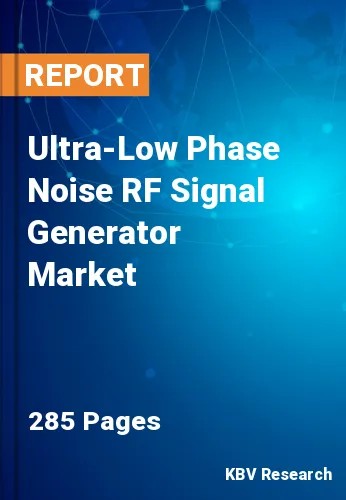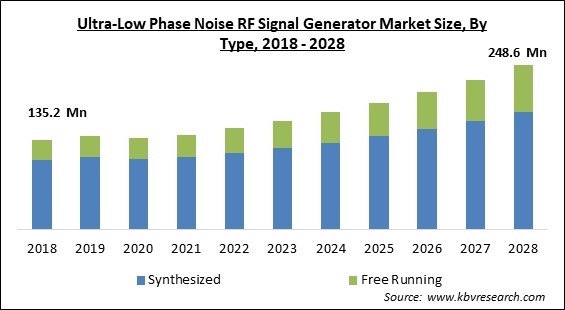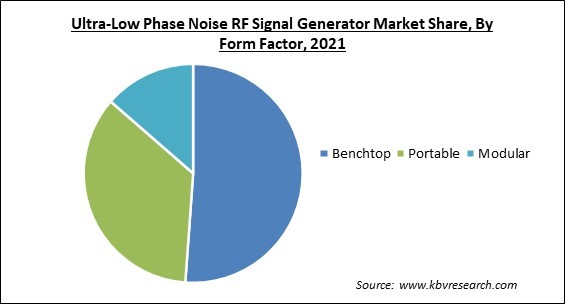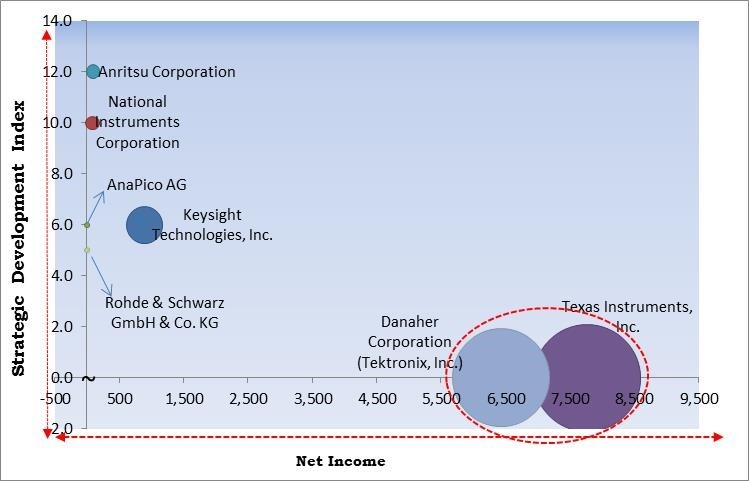
The Global Ultra-Low Phase Noise RF Signal Generator Market size is expected to reach $248.6 million by 2028, rising at a market growth of 8.4% CAGR during the forecast period.
A crucial part of designing circuits and testing electrical signals is played by ultra-low phase noise RF signal generators. They generate waves of electrical signals that serve as a stimulation for the electronic component under test. To achieve the desired output with the least amount of distortion and with greater accuracy, a wave with recognized specifications is required.

It's crucial to test every component's feature when designing a circuit. When going to perform low-power electrical testing, a range of equipment is utilized for different electronic components. It is essential to test components, machines, and receivers by producing the proper signals on a production line or bench.
Error vector magnitude (EVM), Complementary cumulative distribution function (CCDF), occupied bandwidth, channel power, and spectrum are examples of common measurement parameters for test components & transmitters. Important components of receiver testing include the analog receiver chain, receiver sensitivity, and bit error rate (BER).
The market for ultra-low phase noise RF signal generators is expanding as a result of factors including the growing use of smart, 5G-capable devices, rising demand for handheld and portable RF signal generators, and increasing use of synthesized RF signal generators.
The integrated automotive industry has experienced a quick and severe impact as a result of the COVID-19 pandemic. The suspension of Chinese part exports, widespread manufacturing halts in Europe, and the closure of American assembly plants are examples of effects. The export of automotive parts from China to other automotive manufacturers in the European Union has declined. Similarly, the United States, South Korea, Japan, and many other countries could result in a decrease in automotive exports from these economic systems to the rest of the world. This has resulted in reduced demand for ultra-low phase noise RF signal generators across the world.
The growth in smartphone sales & the widespread use of low-cost, high-speed wireless broadband services have both contributed to a significant increase in wireless data traffic over the past few years. There is therefore a critical need for constant, high-bandwidth connectivity. Mobile operators are therefore eager to test 5G network equipment in order to enhance service quality by monitoring interference sources in the spectrum, adjusting cable and antenna systems, and reporting the transmission output power. In order to perform frequency testing during the installation of base stations at antenna tower sites and to build the necessary network infrastructure to control data traffic, ultra-low phase noise RF signal generators are essential.
As a result of the regular advances in 5G technologies, the adoption of Wi-Fi technologies as well as cellular technologies would increase the demand for ultra-low phase noise RF signal generators, especially in information & communication technologies. In wireless communication applications, an ultra-low phase noise RF signal generator is frequently used and typically provides regular analogue modulation, such as frequency modulation (FM), amplitude modulation (AM), and pulse modulation (PM).
Mobile wireless communication system development is labor-intensive and time-consuming. As a result, RF signal generators are constantly in demand from end users in research and development facilities. New generation communication technologies take longer to commercialize and deploy, so there are fewer repeat customers. The second-generation (2G) communication system was introduced after ten years to increase capacity and coverage. The first 3G network was introduced even after a long time period.
Based on type, the ultra-low phase noise RF signal generator market is segmented into synthesized RF signal generators and free running RF signal generators. The free-running RF signal generators segment acquired a significant revenue share in the ultra-low phase noise RF signal generator market in 2021. These low-end, straightforward signal generators occasionally used one or two transistors, provided very basic performance, and were reasonably priced for many experimenters. High-end free running RF generators have the advantage of producing very clean signals with less phase noise on either side of the main signal than some other radio frequency signal generators.
By form factor, the ultra-low phase noise RF signal generator market is fragmented into benchtop, portable and modular. The benchtop segment held the largest revenue share in the ultra-low phase noise RF signal generator market in 2021. This is because they provide high measurement precision at a lower cost, and benchtop signal generators are being used more and more in research & development laboratories all over the world.

On the basis of application, the ultra-low phase noise RF signal generator market is divided into radar systems, component testing equipment and communication systems. In 2021, the radar system segment witnessed the highest revenue share in the ultra-low phase noise RF signal generator market. A variety of simulated radio frequency returns are provided by radar test equipment, which is used at various stages of the development, evaluation, and production cycles. The two main categories of radar test apparatus are environment simulators and target generators.
Based on end use, the ultra-low phase noise RF signal generator market is classified into information & communication technology; aerospace & Defense; semiconductors & electronics; automotive; research & development laboratories and others. In 2021, the information & communication technology segment accounted the largest revenue share in the ultra-low phase noise RF signal generator market. The providers of RF signal generators are concentrating on creating innovations for wireless communication networks.
| Report Attribute | Details |
|---|---|
| Market size value in 2021 | USD 143.6 Million |
| Market size forecast in 2028 | USD 248.6 Million |
| Base Year | 2021 |
| Historical Period | 2018 to 2020 |
| Forecast Period | 2022 to 2028 |
| Revenue Growth Rate | CAGR of 8.4% from 2022 to 2028 |
| Number of Pages | 285 |
| Number of Tables | 463 |
| Report coverage | Market Trends, Revenue Estimation and Forecast, Segmentation Analysis, Regional and Country Breakdown, Competitive Landscape, Companies Strategic Developments, Company Profiling |
| Segments covered | Type, Form Factor, Application, End Use, Region |
| Country scope | US, Canada, Mexico, Germany, UK, France, Russia, Spain, Italy, China, Japan, India, South Korea, Singapore, Malaysia, Brazil, Argentina, UAE, Saudi Arabia, South Africa, Nigeria |
| Growth Drivers |
|
| Restraints |
|
In 2021, the Asia Pacific region led the ultra-low phase noise RF signal generator market with the largest revenue share. This is because of the increasing requirement for RF measurement & testing equipment from the various industries as well as from many research and development (R&D) laboratories in the region. In addition, the region is home to several major suppliers of electronics and connectivity solutions. Additionally, the Asia Pacific region has a strong industry for semiconductor component manufacturers which is rising the demand in the region.
Free Valuable Insights: Global Ultra-Low Phase Noise RF Signal Generator Market size to reach USD 248.6 Million by 2028

The major strategies followed by the market participants are Product Launches. Based on the Analysis presented in the Cardinal matrix; Texas Instruments, Inc. and Danaher Corporation are the forerunners in the Ultra-Low Phase Noise RF Signal Generator Market. Companies such as Keysight Technologies, Inc., Anritsu Corporation and National Instruments Corporation are some of the key innovators in Ultra-Low Phase Noise RF Signal Generator Market.
The market research report covers the analysis of key stake holders of the market. Key companies profiled in the report include Texas Instruments, Inc., Anritsu Corporation, Keysight Technologies, Inc., National Instruments Corporation, Danaher Corporation (Tektronix, Inc.), Berkeley Varitronics Systems, Inc., B&K Precision Corporation, Tabor Electronics, AnaPico AG and Rohde & Schwarz GmbH & Co. KG
By Type
By Form Factor
By Application
By End Use
By Geography
The global Ultra-Low Phase Noise RF Signal Generator Market size is expected to reach $248.6 million by 2028.
Increasing Use Of 5G-Capable and Smart Devices are driving the market in coming years, however, Research and Development of New Cellular Networks Takes More Time restraints the growth of the market.
Texas Instruments, Inc., Anritsu Corporation, Keysight Technologies, Inc., National Instruments Corporation, Danaher Corporation (Tektronix, Inc.), Berkeley Varitronics Systems, Inc., B&K Precision Corporation, Tabor Electronics, AnaPico AG and Rohde & Schwarz GmbH & Co. KG.
The Synthesized market is generating high revenue in the Global Ultra-Low Phase Noise RF Signal Generator Market by Type in 2021; thereby, achieving a market value of $178 million by 2028.
The Component Testing Equipment market shows high market share in the Global Ultra-Low Phase Noise RF Signal Generator Market by Application in 2021; thereby, achieving a market value of $112 million by 2028.
The Asia Pacific market dominated the Global Ultra-Low Phase Noise RF Signal Generator Market by Region in 2021; thereby, achieving a market value of $95 million by 2028.
Our team of dedicated experts can provide you with attractive expansion opportunities for your business.
